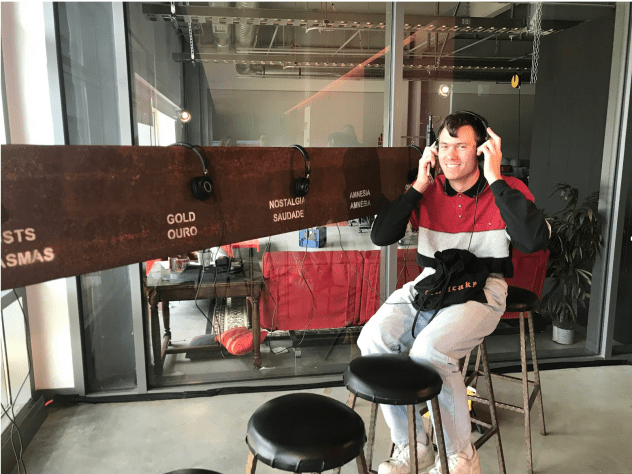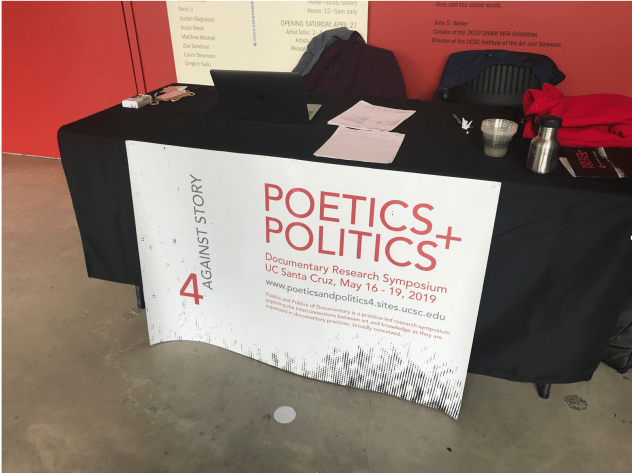POETICS + POLITICS: DOCUMENTARY RESEARCH SYMPOSIUM
UC Santa Cruz, May 16-19, 2019
Ceara Eisworth
Film & Digital Media Department, UCSC Undergraduate Student
The fourth Poetics & Politics took place over a four day span, held at UC Santa Cruz in the Digital Arts Research Center. It confronted many topics and discussions related to documentary filmmaking practice, but was centered around the idea of going “against story,” refuting the traditional narrative form taken so often in modern day documentary. Though attendees addressed many subjects throughout extensive interactive panels, this topic highlighted the direction of the symposium. Curated by UCSC’s Irene Gustafson and Irene Lusztig, the event sought to create a conversation about the current state of documentary practice and how we as filmmakers can better challenge preconceived notions of how to create successful documentary.
Though unrelated to the actual symposium itself, we began with a quick speech from members of the labor strikes happening currently on UCSC’s campus who were invited by Gustafson and Lusztig as a strike was happening the same day as the first of the symposium. Following this, a short background of the history of Poetics & Politics was given and attendees were slowly brought into the basis of conversation for the weekend. They were asked to think critically about documentary, and it was stated that this can foster a “sense of community and critical questioning.” Then an extremely important question was posed to the audience: What does it mean to put story and documentary together? Irene Lusztig presented the introduction, placing emphasis on the desire of the curators to start the day together and end it together despite having parallel panels.
The first panel was about framing story, and was one of the main drivers for the symposium, as much of the event discussed the manifesto Beyond Story by Alexandra Juhasz and Alisa Lebow, written for public online accessibility. Rick Prelinger and Sindhu Thirumalaisamy were the first presenters of the weekend, and already provoked questions and critical thought from the very beginning. Thirumalaisamy stated that Prelinger’s presentation even made her question some of the ideas she had wanted to speak about. He discussed the history of storytelling, and how it began as a progressive mode. Arguably the most memorable point of his discussion was his theory of space in the cinema and the concept of audience interaction. He claimed that it once was well received and even encouraged, but has been shunned out of our theaters today. In this way, audiences used to go to the theater to actually represent themselves as Prelinger emphasized. He looked at these screenings as community projects and joked that his perfect “crowd” would be that of a sports crowd because they are extremely vocal in their presence. Prelinger really pushed against not only narrative, but filmmaking overall. He made a comment which should be duly noted, that we can’t “stop story’s history, but can stop internalizing it.” Along with this theory he emphasized that not all stories are filmmable and that it will take public assemblies to combat. Overall, this first panel set the stage for discussions to happen throughout the symposium, and the next speaker Sindhu Thirumalaisamy carried this discussion over, but turned away from the theater space a bit more and focused on her film Kere Mattu Kere, which focuses on a polluted environment, derailing the usage of environment as background for individual narrative, but rather as its own part. She said something very interesting, that “the lake has made the film too in some ways. It is not just the subject of it.” Questions such as, “What do narratives of crisis obscure?” and “What is being left out of the picture?” were raised, but the first actual panel discussion is where the symposium started taking off.
Interaction with the attendees in these discussions were extremely provocative in terms of seeking to understand this concept of going “against story.” Someone asked where the panelists sat with this idea to which Sindhu responded that the term “against,” was a bit too concrete of a position. Overdone are stories of the victim, suffrage, and other normalized structures, but it was added that this doesn’t mean there is absolutely no room for story in documentary filmmaking. A main conclusion of the symposium was that story, in fact, shouldn’t be completely demolished, but should definitely be decentered in order to push documentary forward. Other points which came out of this beginning panel were “Why are stories dominating new media that doesn’t require it?” and that this moment of collapse in documentary can also be a moment of opportunity. Isabelle Carbonell, a PHD Candidate at UC Santa Cruz also critiqued this very definition of “story,” questioning whether it is always a three-point arc, or if we can redefine its meaning at the core.
Many sessions interrogated these broad subjects through different lenses of looking at documentary through topics such as history, surveillance, archive, landscape, animal, and more. Keynote speaker Lana Lin, discussed the ability of poetry to “materialize possibility,” through her film The Cancer Journals Revisited, bringing up some interesting concepts. Lin stated that the film was a permeable subject, “held together by me,” and then emphasized the pronouns, “I,” “we,” and “it (referring to the cancer).” Lin also said that readers stand in as a function, and that the film acts as a self-revelation for the filmmaker. Turning the concept of a defined narrative on its head, Lin’s film rejects the “normatively human,” and goes against the voyeuristic and pornographic gaze upon survivorship. Lin said that illness cannot be chalked down into one story, which calls upon another important concept of using polyvocality to combat traditional story based documentary.
Polyvocality was also mentioned in other panels dealing with collectivized work, shown by Jeanne C. Finley, Iphigenie Marcoux-Fortier, Amy Magowan Greene, Meky Ottawa, and Rabia Williams. This concept of bringing multiple voices into a piece of work was yet another example of ways we can challenge story discussed in the symposium.
Although the main subject of the event was what it means to incorporate story, and equally what it means to reject story, there was an overarching questioning of the history and path of documentary filmmaking. Kirsten Johnson, another keynote speaker at this Poetics & Politics creates thought around the filmmaker and the filmed, and the rapid change of this industry.
At the end of the four day event, a debate of empathy was brought to light, with an attendee adding that “story is often full of empty emoting, no thoughts strung along.” Comments such as that “it is not necessarily binary,” and that we should “make what is not evident the evidence,” were also said. Overall, it mostly came to a consensus that there needs to be a pushback of the idea that narrative is “natural to humans,” and that it should be centered in our practice. Finishing with a discussion on how to actually enact change in this realm, it was decided by some that the next steps would be to possibly write letters, or invite big industry producers to events such as Poetics & Politics to receive a chance at seeing topics such as going beyond, or against, story in a new light.

